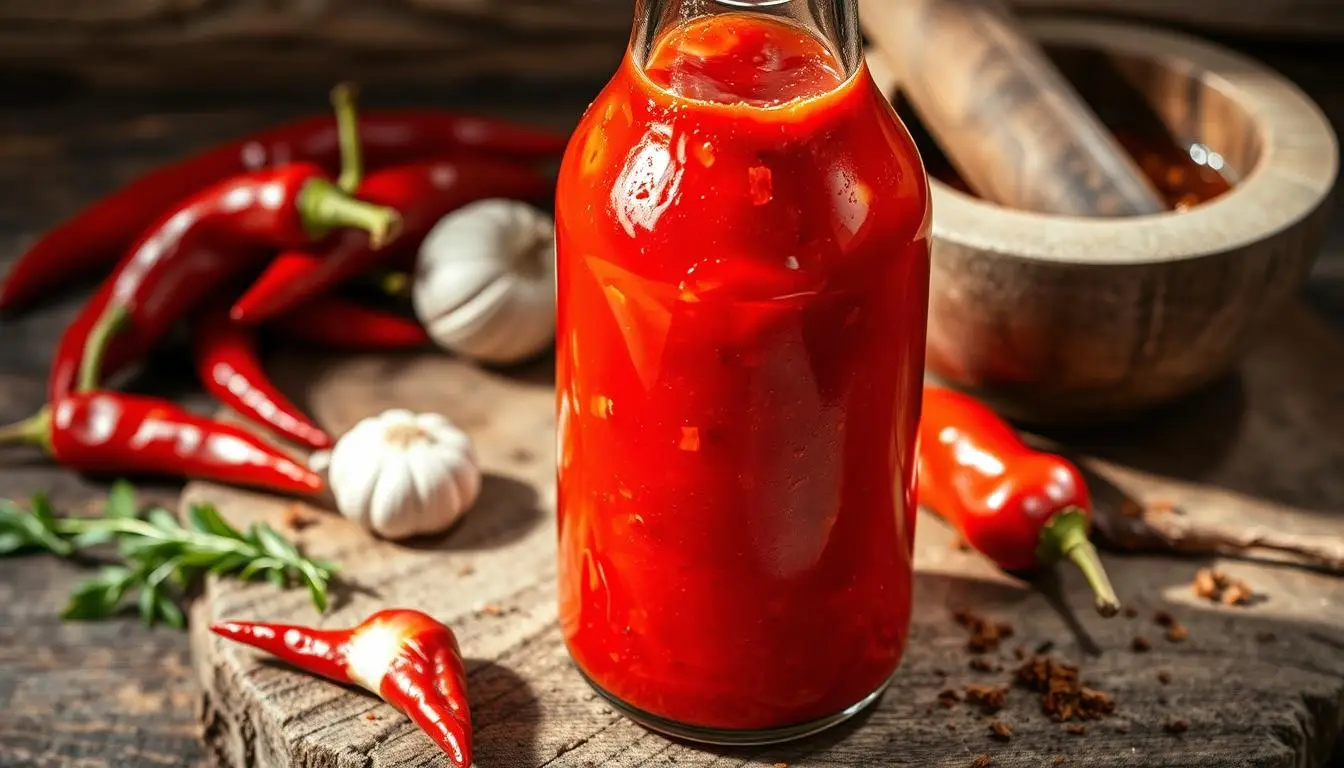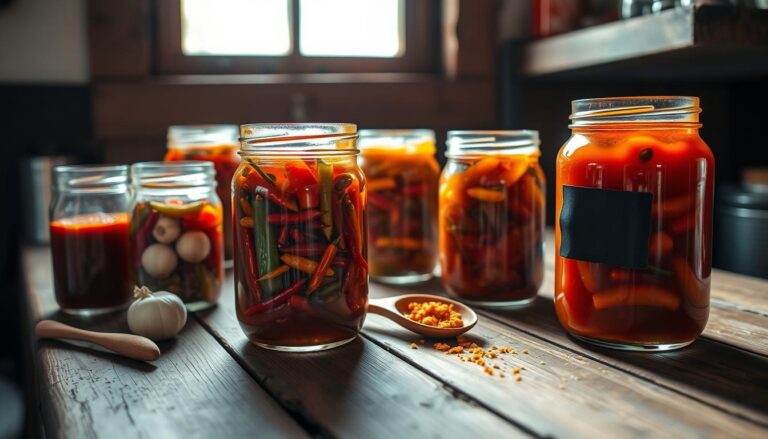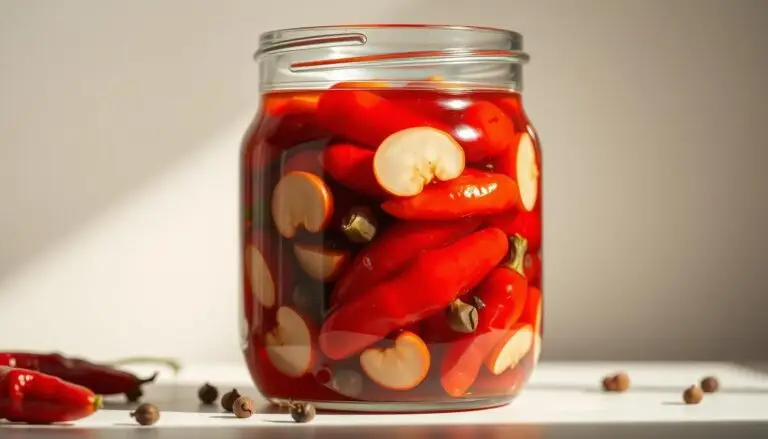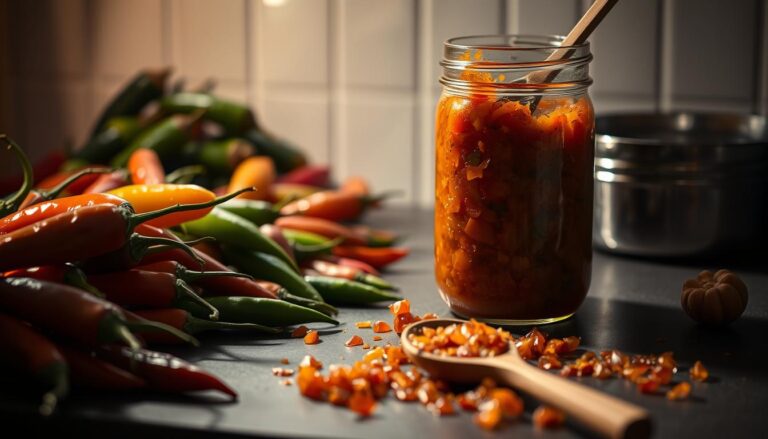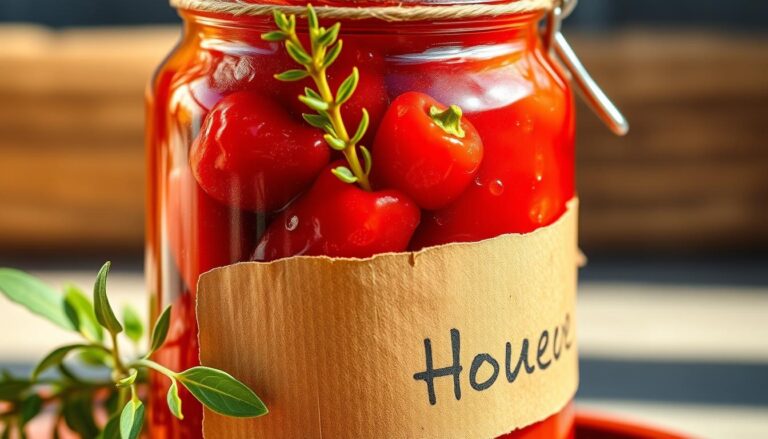Fermented Hot Sauce: Tips for Creating Bold, Flavorful Sauce at Home
Table of Contents
Start your journey into homemade fermented hot sauce. It’s where creativity meets ancient ways of preserving food. Making the perfect spicy sauce is a mix of patience and skill.
Homemade fermented hot sauce lets you explore flavors not found in store-bought ones. It’s different from quick sauces because it uses natural bacteria. This creates deep, rich tastes that will make your dishes better. You can wait from 1 week to several months to get the perfect taste.
The secret to great fermented hot sauce is choosing the right peppers. You can pick from mild jalapeños to very hot Carolina Reapers. Your sauce will show off your creativity, making everything from grilled meats to seafood dishes better.
Get ready for a flavorful adventure in your kitchen. With each batch, you’ll get better at mixing heat, acidity, and flavor. Your homemade fermented hot sauce is a sign of your love for cooking.
Understanding the Art of Fermented Hot Sauce
Explore the world of probiotic hot sauce, where science and cooking come together. This hot sauce is made by turning chili peppers into a rich, flavorful condiment. It’s done through a natural process called lacto-fermentation.
The journey starts with a mix of salt, peppers, and time. This mix lets beneficial bacteria work their magic. They turn the sauce into something delicious and good for you.
The Science of Fermentation
Fermentation is a way to preserve food naturally. It turns simple ingredients into amazing flavors. Here’s how it works:
- Creating the right salt concentration (2-3% brine)
- Maintaining optimal temperature (68-72°F)
- Allowing beneficial bacteria to thrive
Benefits Beyond Traditional Methods
Lacto-fermented hot sauce has special benefits:
- Probiotic powerhouse supporting gut health
- Deeper, more complex flavor profile
- Natural preservation without artificial additives
Flavor Development Stages
The fermentation process has different stages. Bacteria change from Leuconostoc mesenteroides to Lactobacillus plantarum. Each stage adds to the sauce’s unique taste. The pH drops from 6.5 to a tangy 3.4-3.8.
Fermentation is where science meets culinary art, creating a symphony of flavors in every drop of hot sauce.
Essential Equipment and Ingredients for Fermentation
Making a tasty spicy fermented condiment needs the right tools and ingredients. Start your natural fermentation hot sauce journey by picking the best equipment and ingredients. These will turn simple peppers into a rich, flavorful sauce.
Here are the must-have tools for your fermentation project:
- Large glass mason jars (wide-mouth recommended)
- Fermentation weights or airlock lids
- Kitchen scale for precise measurements
- pH testing strips
- High-powered blender or immersion blender
When choosing ingredients for your natural fermentation hot sauce, focus on these key items:
- Fresh peppers: Mix hot and sweet varieties for a rich flavor
- Sea salt or kosher salt for brine
- Unchlorinated water
- Optional flavor enhancers like garlic, herbs, or fruits
Your fermentation success depends on the right environment. Keep your fermentation vessel at a consistent temperature between 60-75°F. This ensures the best bacterial growth for your spicy fermented condiment. With the right equipment and fresh ingredients, you’ll make an amazing homemade hot sauce.
Choosing the Right Peppers for Your Sauce
Creating a great fermented chili sauce begins with picking the right peppers. The type of pepper you choose greatly affects the sauce’s taste, heat, and complexity. This is key for making a top-notch artisan fermented hot sauce.
Popular Pepper Varieties and Heat Levels
Knowing about pepper heat levels is essential for making the perfect sauce. The Scoville Heat Unit (SHU) scale is very helpful:
- Mild Peppers (0-5,000 SHU): Banana, Ancho, Poblano
- Medium Peppers (5,000-30,000 SHU): Jalapeño, Serrano
- Hot Peppers (30,000-100,000 SHU): Cayenne, Tabasco
- Extreme Heat Peppers (100,000+ SHU): Habanero, Ghost Pepper, Carolina Reaper
Combining Peppers for Complex Flavors
Experts in hot sauce making blend peppers for amazing depth. Mixing milder peppers with hotter ones creates a sauce that’s both spicy and flavorful. This balance is what makes a sauce truly special.
Fresh vs Dried Pepper Options
Choosing between fresh and dried peppers can change your sauce a lot. Fresh peppers give a bright, fresh taste. Dried peppers offer a richer, more intense flavor. Try different combinations to find what works best for you!
Pro Tip: Organic, homegrown chiles are preferred to avoid pesticides that might interfere with fermentation.
Salt Brine vs Mash Method: Which to Choose
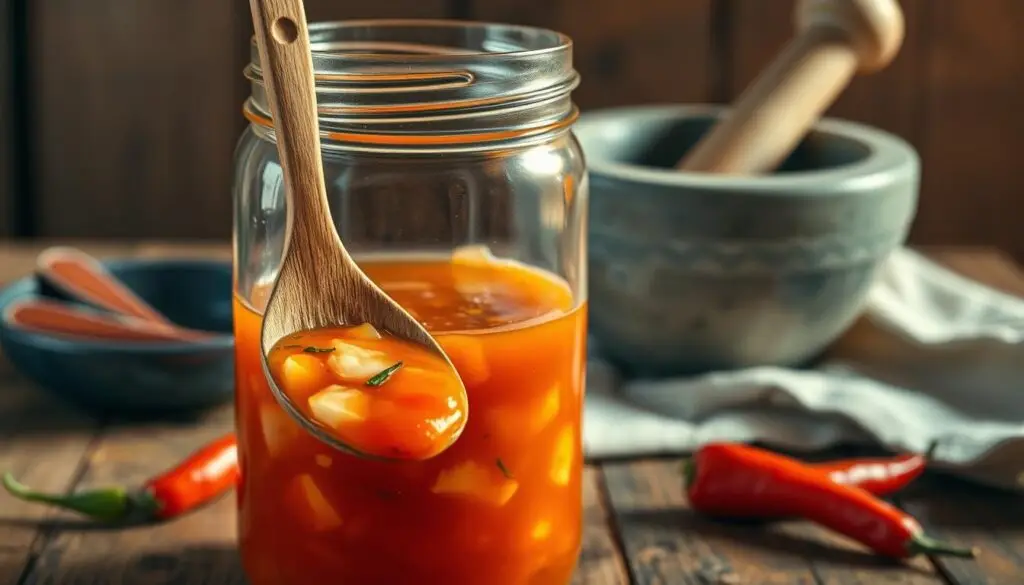
When making tangy fermented hot sauce, you have two main methods: salt brine and mash. Each method has its own benefits for making a tasty sauce. They help bring out complex flavors and keep your ingredients fresh.
The salt brine method uses a saltwater solution to cover whole or chopped peppers. You should aim for 2-3% salt by weight of water. This method ensures all ingredients are covered and creates a perfect environment for fermentation.
Salt Brine Method Advantages
- Protects ingredients from oxygen exposure
- Enables uniform fermentation
- Easier to monitor fermentation progress
- Produces a more liquid-based sauce
Mash Method Characteristics
- Requires 2-5% salt by total ingredient weight
- Creates a thicker, more concentrated sauce
- Allows for more direct flavor interaction
- Ideal for creating intense, robust fermented hot sauce
Choosing between salt brine and mash depends on your sauce’s consistency and flavor. For a lighter sauce, go with the brine method. For a thicker sauce, choose the mash method.
“The magic of fermentation lies in understanding your ingredients and selecting the right preparation method.” – Fermentation Expert
| Method | Salt Concentration | Sauce Consistency | Fermentation Time |
|---|---|---|---|
| Salt Brine | 2-3% water weight | Liquid | 7-14 days |
| Mash | 2-5% ingredient weight | Thick | 10-21 days |
Whichever method you pick, keep the temperature between 68-72°F. Also, watch the pH levels to make sure your sauce is safe and delicious.
Complementary Ingredients and Flavor Enhancers
Making a top-notch artisan fermented hot sauce is more than just peppers. The right mix of ingredients can turn your probiotic hot sauce into something special. These additions are like flavor architects, adding depth and balance to your sauce.
To make a standout probiotic hot sauce, pick ingredients that boost the pepper flavor. Let’s look at the key parts that make your sauce unique.
Aromatic Foundations
Aromatics are the heart of an artisan fermented hot sauce. They add layers of flavor and depth:
- Garlic: Provides robust, earthy undertones
- Onions: Contribute sweet and pungent notes
- Shallots: Offer a more delicate, refined flavor
Fruits and Vegetables
Fruits and vegetables can balance the heat and add nutrition to your probiotic hot sauce. Some great choices include:
- Mangoes: Bring tropical sweetness
- Pineapples: Add tangy brightness
- Bell peppers: Contribute mild pepper flavor and vibrant color
Spice and Sweetness
The perfect mix of spices and sweeteners can take your artisan fermented hot sauce to the next level:
- Cumin: Adds warm, earthy undertones
- Smoked paprika: Introduces subtle smokiness
- Honey: Provides natural, gentle sweetness
- Maple syrup: Offers complex, rich sweetness
Trying out these ingredients lets you make a probiotic hot sauce that’s truly yours. It shows off your cooking skills and taste.
Step-by-Step Fermented Hot Sauce Process
Making homemade fermented hot sauce is a fun journey. It turns simple ingredients into a tangy, complex condiment. This process needs patience and focus, but it’s worth it.
- Pepper Preparation
- Wash and chop fresh peppers
- Remove stems and seeds (optional)
- Wear gloves to protect your skin
- Salt Brine Creation
- Use 2-3% salt concentration
- Dissolve 25 grams of salt per liter of water
- Ensure salt is fully dissolved
- Fermentation Setup
- Pack peppers into clean fermentation jar
- Pour salt brine to cover peppers completely
- Use fermentation weight to keep peppers submerged
Fermentation takes 3-5 weeks. The best temperature is 68-72°F. During this time, good bacteria change your ingredients. They create a rich, complex flavor.
| Fermentation Stage | pH Level | Duration |
|---|---|---|
| Initial Stage | ~6.5 | Days 1-3 |
| Middle Stage | ~4.0 | Days 4-10 |
| Final Stage | 3.4-3.8 | Days 11+ |
After fermentation, blend your sauce to the right consistency. Strain if needed, then bottle. Your homemade fermented hot sauce will last up to a year in the fridge. It’s a probiotic-rich, flavorful condiment that beats store-bought ones.
Fermentation Timeline and Monitoring
Making a natural fermentation hot sauce needs careful timing and the right environment. The success of your spicy fermented condiment depends on knowing the fermentation process well.
The journey to making your sauce involves several important stages. These stages turn your ingredients into a flavorful sauce. Let’s look at the main parts of monitoring your fermentation.
Temperature and Environmental Factors
The best fermentation happens in a certain temperature range. The perfect spot for your hot sauce is between 68-72°F (20-22°C). Changes in temperature can greatly affect the fermentation.
- Keep the room temperature steady
- Avoid direct sunlight
- Use a spot with controlled temperature
Signs of Successful Fermentation
It’s important to know when fermentation is going well. Look for these signs:
| Stage | Key Indicators | pH Range |
|---|---|---|
| Early Stage (Days 1-3) | Bubbling, slight color change | 6.5 to 5.0 |
| Middle Stage (Days 4-10) | Increased tangy flavor, more bubbling | 5.0 to 4.0 |
| Late Stage (Days 11+) | Developed complex flavor, stabilized pH | 3.4 to 3.8 |
Troubleshooting Common Issues
Even the most skilled fermenters face problems. Watch out for these common issues:
- Kahm yeast: A white film that might mean spoilage
- Unusual smells or mold
- No bubbling or activity
Creating the perfect natural fermentation hot sauce takes patience. Keep a close eye on your spicy fermented condiment. With time and care, you’ll get a sauce with deep, rich flavors.
Safety Precautions and Best Practices
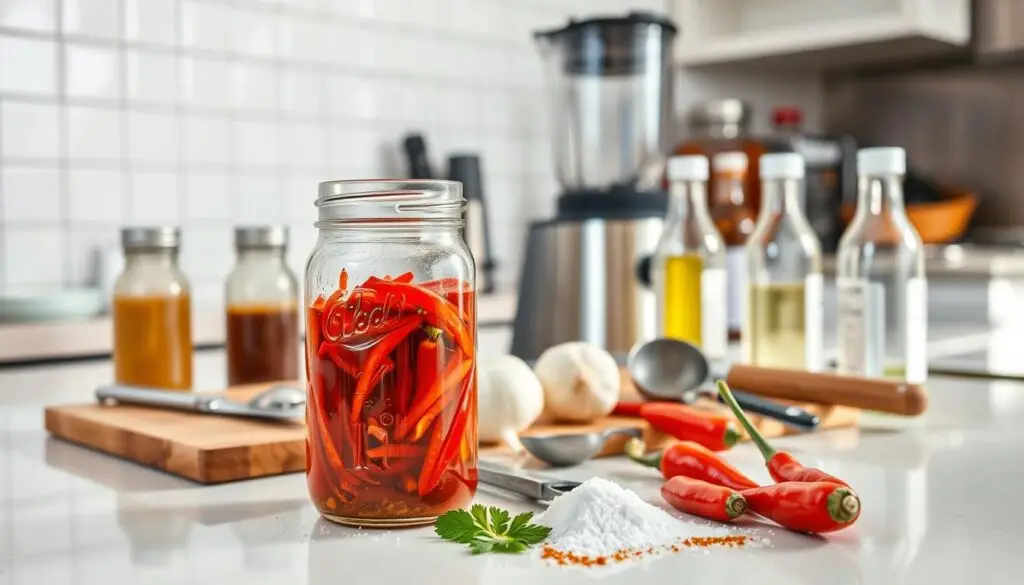
Making probiotic hot sauce safely means paying close attention to details and keeping things clean. When you make fermented hot sauce at home, you aim to stop bad bacteria while helping good bacteria grow.
Important safety tips for your fermented hot sauce include:
- Use sterilized equipment to prevent contamination
- Maintain proper salt concentration between 2-3% by weight
- Ensure ingredients remain fully submerged during fermentation
- Monitor pH levels to create a safe fermentation environment
The fermentation process for hot sauce has specific bacterial stages. Leuconostoc mesenteroides leads the first 1-3 days, and Lactobacillus plantarum takes over from days 4-10. This helps create complex flavors and keeps your probiotic hot sauce safe.
Temperature control is key. Keep your fermentation area between 68-72°F, avoiding the dangerous 40-140°F range. Your pH should drop from about 6.5 to 3.4-3.8, which stops harmful bacteria.
When working with hot peppers, wear gloves and work in a well-ventilated area. Capsaicin can irritate skin and eyes, so protect yourself during the preparation.
Post-Fermentation Processing and Storage
After your tangy fermented hot sauce is fermented, it’s time to make it into a tasty condiment. The last steps are important for a great artisan fermented hot sauce. It will surely delight your taste buds.
Straining and Blending Techniques
Your fermented pepper mix needs careful processing for a smooth sauce. Here are some ways to improve your tangy fermented hot sauce:
- Strain through a fine-mesh sieve to remove solids
- Use a blender to achieve desired smoothness
- Add small amounts of vinegar to enhance flavor and preservation
Bottling and Preservation Methods
Proper bottling keeps your artisan fermented hot sauce fresh and flavorful. Try these preservation tips:
- Sterilize glass bottles before filling
- Leave a small air gap at the top of the bottle
- Use airtight lids to prevent contamination
Shelf Life and Storage Conditions
Refrigeration is essential for a longer shelf life. Stored right, your sauce can last up to three months. Keep it at 35-40°F to slow down fermentation and keep flavors bright.
Pro tip: Always use clean utensils when handling your sauce to prevent introducing new bacteria.
Creative Recipe Variations and Uses
Your homemade fermented chili sauce is more than just a condiment. It’s a culinary adventure waiting to transform your favorite dishes. This spicy fermented condiment can elevate everything from breakfast to dinner, adding depth and complexity to your meals.
- Breakfast Boost: Drizzle over scrambled eggs or avocado toast
- Marinade Magic: Use as a marinade for grilled meats and vegetables
- Cocktail Kick: Add a splash to Bloody Marys or micheladas
- Sandwich Upgrade: Spread on sandwiches for an extra flavor punch
- Dipping Delight: Create unique dipping sauces for appetizers
Experimenting with your fermented chili sauce opens up a world of culinary possibilities. The beauty of this spicy fermented condiment lies in its versatility. Try mixing it with:
- Mayonnaise for a zesty aioli
- Honey for a sweet-hot glaze
- Olive oil for a vibrant salad dressing
“The best recipes are born from culinary curiosity and fearless experimentation!” – Chef’s Wisdom
Pro tip: Start with small amounts of your fermented chili sauce and gradually increase to find your perfect heat level. Each batch will have a unique flavor profile, making every cooking experience an exciting journey.
Conclusion
Making your own fermented hot sauce is more than a cooking project. It’s a journey into flavor, health, and creativity. You turn simple peppers into a rich, nutritious sauce that makes any dish better and helps your digestion.
Your adventure with fermented hot sauce opens up new culinary paths. With each batch, you’ll see how fermentation brings out the best in peppers. This sauce is not just hot; it’s full of depth and flavor. Plus, the probiotics in it are great for your gut and immune system.
Every jar of fermented hot sauce you make is special. It’s a chance to try new things and create a sauce that’s all yours. You get to pick the peppers and watch the fermentation progress. It’s more than a sauce; it’s a way to connect with old food-making traditions and enjoy a healthy, tasty condiment.
Your homemade fermented hot sauce journey is just starting. Dive into it, trust your taste, and enjoy the tangy flavors you’ll make with each batch.
Chef-Approved Kitchen Gear for Easy Cooking
- Large glass mason jars (wide-mouth recommended)
- Fermentation weights or airlock lids
- Kitchen scale for precise measurements
- pH testing strips
- High-powered blender or immersion blender
Check this list For More Hot Recipes Tips

